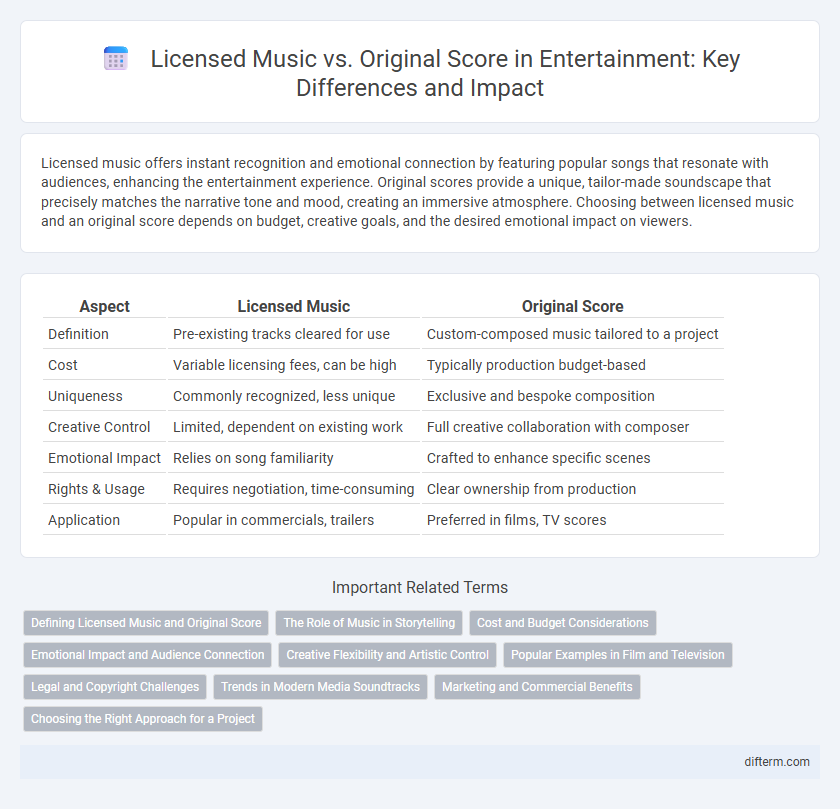Licensed music offers instant recognition and emotional connection by featuring popular songs that resonate with audiences, enhancing the entertainment experience. Original scores provide a unique, tailor-made soundscape that precisely matches the narrative tone and mood, creating an immersive atmosphere. Choosing between licensed music and an original score depends on budget, creative goals, and the desired emotional impact on viewers.
Table of Comparison
| Aspect | Licensed Music | Original Score |
|---|---|---|
| Definition | Pre-existing tracks cleared for use | Custom-composed music tailored to a project |
| Cost | Variable licensing fees, can be high | Typically production budget-based |
| Uniqueness | Commonly recognized, less unique | Exclusive and bespoke composition |
| Creative Control | Limited, dependent on existing work | Full creative collaboration with composer |
| Emotional Impact | Relies on song familiarity | Crafted to enhance specific scenes |
| Rights & Usage | Requires negotiation, time-consuming | Clear ownership from production |
| Application | Popular in commercials, trailers | Preferred in films, TV scores |
Defining Licensed Music and Original Score
Licensed music refers to pre-existing songs or compositions that are legally authorized for use in films, television shows, and other media through licensing agreements, ensuring proper rights management and royalty payments. An original score is a customized musical composition created specifically to accompany and enhance the emotional and narrative aspects of a particular production. The distinction lies in licensed music being reused content, while original scores are unique creations tailored to the project's thematic and atmospheric needs.
The Role of Music in Storytelling
Licensed music enhances storytelling by leveraging familiar melodies and cultural connotations that instantly evoke emotions and set the scene, creating a connection with the audience. Original scores provide tailored compositions that reflect narrative nuances and character development, deepening immersion through unique thematic motifs. Both elements serve crucial functions in shaping atmosphere, reinforcing themes, and driving emotional impact within films and television.
Cost and Budget Considerations
Licensed music often incurs fixed fees and royalties that can significantly impact production budgets, especially for popular tracks with high demand. Original scores require investment in composers, musicians, and studio time but offer greater flexibility and long-term cost efficiency by eliminating ongoing royalty payments. Balancing upfront expenses against potential royalties is crucial for producers aiming to optimize their entertainment project's financial plan.
Emotional Impact and Audience Connection
Licensed music often evokes strong nostalgia and immediate recognition, enhancing emotional impact by tapping into existing cultural associations. Original scores create a unique auditory identity tailored to the narrative, fostering a deeper, more intimate audience connection through thematic consistency and subtle emotional cues. Both approaches strategically influence viewers' emotions, but original scores typically offer more nuanced and personalized storytelling experiences.
Creative Flexibility and Artistic Control
Original scores provide unparalleled creative flexibility and artistic control, allowing composers to tailor music precisely to the mood, pacing, and narrative of a film or show. Licensed music offers recognizable appeal but limits adjustments, as creators must work within pre-existing track structures and rights constraints. This distinction significantly impacts the emotional resonance and unique identity of the entertainment project.
Popular Examples in Film and Television
Licensed music in film and television often features chart-topping hits like Queen's "Bohemian Rhapsody" in *Wayne's World* or Tupac's "California Love" in *Grand Theft Auto* series, creating instant audience recognition. Original scores, composed by maestros like John Williams for *Star Wars* or Hans Zimmer for *Inception*, provide thematic depth and emotional resonance tailored specifically to the narrative. The strategic blend of licensed tracks and original scores enhances storytelling by balancing familiarity with unique auditory experiences.
Legal and Copyright Challenges
Licensed music involves acquiring rights from copyright holders, requiring complex negotiation of synchronization, performance, and mechanical licenses to avoid infringement. Original scores, composed specifically for a project, offer greater control over rights and distribution but demand upfront investment and clear agreements with composers regarding ownership and royalty terms. Both approaches face legal scrutiny to ensure compliance with copyright law, emphasizing the importance of meticulous contract management to mitigate risks in film, television, and digital media production.
Trends in Modern Media Soundtracks
Licensed music in modern media soundtracks often leverages popular, recognizable tracks that amplify audience connection through familiarity and nostalgia. Original scores are increasingly crafted with hybrid orchestration and electronic elements, reflecting trends toward immersive and emotionally nuanced storytelling. Streaming platforms and video games frequently blend licensed hits with unique compositions to enhance dynamic user experiences and brand identity.
Marketing and Commercial Benefits
Licensed music in marketing campaigns leverages popular songs to instantly connect with audiences and boost brand recognition, driving higher engagement and sales. Original scores allow brands to create unique auditory identities that enhance emotional resonance and memorability in commercials, fostering long-term brand loyalty. Combining licensed tracks and bespoke compositions maximizes commercial impact by balancing familiarity with distinctiveness in entertainment marketing strategies.
Choosing the Right Approach for a Project
Choosing between licensed music and an original score depends on the project's budget, creative vision, and target audience. Licensed tracks offer immediate recognition and emotional impact, while original scores provide unique, tailored soundscapes that enhance narrative depth. Balancing cost, copyright considerations, and artistic goals is essential for achieving the desired audience engagement.
Licensed music vs original score Infographic

 difterm.com
difterm.com